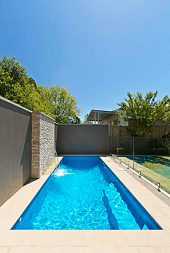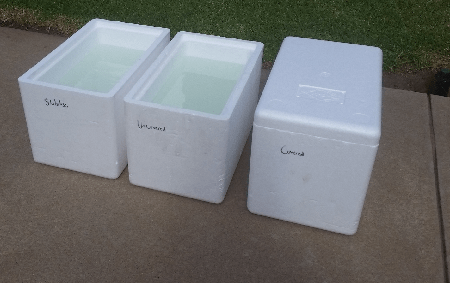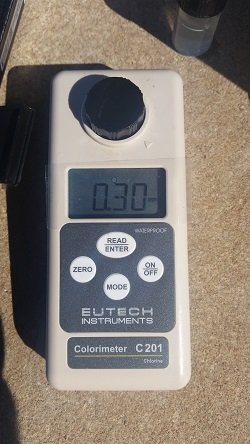Why do I need to re-Chlorinate so often on a sunny day?
Why do I need to re-Chlorinate so often on a sunny day? |
 | Chlorine is commonly used in pools to kill bacteria and algae; this is because it is a known disinfectant. It works by producing hypochlorite ions, which under the effect of sunlight release oxygen free radicals. The oxygen free radical reacts with all organic matter it encounters, killing the bacteria present in water. Some chlorine molecules that fail to ionize in water also react with organic matter. However, Chlorine does have its disadvantages and one of them is the fact that the hypochlorite ions decompose very quickly under sunlight, on a cloudless sunny day, 90% of the chlorine level in a pool can be destroyed in about two hours. This can mean that pools need to be chlorinated repeatedly to keep the levels at the required level to kill bacteria. In this month’s experiment we are going to investigate the effects of sunlight on Chlorine within water and the way in which thermal blankets and chlorine stabilisers can keep the levels higher over a period of time. | |||||||||||||||||||||
3 x Foam Containers (10L capacity) 1 x Foam Container lid to replicate a thermal blanket 1 x Tub (30L capacity) 1 x EC-C201 - Free Chlorine and Total Chlorine Colorimeter 25 x 94X377001 - Free Chlorine Reagent 1 x 500g Bag of Granulated Chlorine 1 x 2kg Bag of Pool Stabiliser Method 1) A large tub had water added to it until there was 24L of water available. Granulated Chlorine was then added to the tub and a measurement was under taken using the EC-C201 in the Free Chlorine mode. Measurements were continually performed and Chlorine added until a 1.14ppm of Free Chlorine level was reached (a healthy pool should have a level between 1 and 3 ppm). 2) The water in the large tub was then separated into 3 separate 8L containers. 0.4g of stabiliser was added to one tub as per the manufacturer’s instructions for the 8L volume. The second tub was then covered using a foam lid (to replicate a pool blanket) and the final blanket was left uncovered. 3) The 3 tubs were then taken outside and placed in a sunny area.  Figure 1: All containers outside ready for testing
 Figure 2: Reading of uncovered sample after 3 hours
Table 1: Results of Free Chlorine levels (ppm) and UV levels over time The reason that this significant drop did not occur with the covered container is that UV cannot enter and as such there is no way for it to break down by way of UV. In saying this the break down that did occur may have been due to the fact the free Chlorine reacted with organic matter and bacteria within the water causing the level to drop. This is also similar to what occurred with the stabilised container, Stabiliser contains Cyanuric acid and when this reacts with Free Chlorine it forms a compound that does not react with UV and as such maintains chlorination levels in outdoor pools that have a high degree of contact with sunlight. This experiment shows that in order to keep your Chlorine levels higher over a period of time you are best to either cover your pool to stop or reduce contact with UV or add stabiliser to your pool to keep levels higher over a period of time. If you would like to discuss this experiment further please contact one of our friendly Scientists via email or phone on 1300 737 871. By Daniel Craig McGaffin By Daniel craig McGaffin | ||||||||||||||||||||||
See our other newsletter articles here!
Contact our expert scientists now to get the right meter or data logger to suit your needs and discuss your project.
Phone: 1300 737 871
Email: [email protected]
